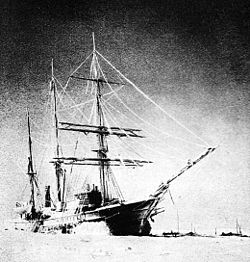Zarya (polar ship)
 Zarya in 1902 during her second wintering
| |
| History | |
|---|---|
| Name | Harald Harfager |
| Builder | Brinchs Verft, Oslo, Norway |
| Launched | 1873 |
| Name | Zarya |
| Owner | Russian Academy of Sciences |
| Builder | Brinchs Verft, Oslo, Norway |
| Cost | Purchased for ₽60,000 |
| Launched | 1873 |
| Acquired | 1899 |
| Commissioned | 1900 |
| Decommissioned | 1902 |
| In service | 1900 |
| Out of service | 1902 |
| Fate | Sunk by her crew and abandoned due to having suffered too much damage |
| General characteristics | |
| Class and type | Barque |
| Tons burthen | 450 tons |
| Draught | 5 m |
| Propulsion | Steam engine |
| Sail plan | barkentine |
| Complement | Crew of 20 |
| Armament | None |
Zarya (Russian: Заря, Sunrise or Dawn) was a steam- and sail-powered brig used by the Russian Academy of Sciences for a polar exploration during 1900–1903.
History
Toward the end of the 19th century, the
Renamed Zarya, the ship was sent to the shipyard of Colin Archer in Larvik to be heavily modified in order to deal with the ice. Colin Archer, the renowned Norwegian shipbuilder, had designed and built Fritdjof Nansen's ship Fram, which in 1896 had returned unscathed from its long drift in the northern polar ocean during Nansen's "Farthest North" expedition, 1893–96. Archer had also fitted out Southern Cross for the Southern Cross Expedition in 1897 to become a polar ship. Archer strengthened Zarja heavily with internal frames and beams and deckhouses were added and modified. The rig was changed to barkentine (square sail on foremast only). In October 1899 the ship was certified by Norwegian authorities for a three-year expedition in the Arctic.
Russian Polar Expedition
On June 21, 1900, Zarya left
In August 1901 the ship headed across the
Badly beaten by the ice, and beyond any hope of repair, Zarya was finally moored east of the
 |
 |
Honours
Today, the city museum in Polyarny, Russia keeps documents and artifacts related to the expedition.[1]
An island in the vicinity of Cape Chelyuskin (Остров Заря) at 77°37′N 104°24′E / 77.617°N 104.400°E, as well as a peninsula east of the Middendorff Bay (полуостров Заря) and the strait between Belkovsky Island and Kotelny Island were named Zarya to commemorate this Russian polar ship.
Further reading
- William Barr (Arctic historian), Baron Eduard von Toll's Last Expedition: The Russian Polar Expedition, 1900-1903
- The contribution of the Russian polar expedition (1900–1903) in oceanographic investigation of the Arctic Seas of Russia
References
- ^ City Museum (Russian)
External links
- History of Zarya and the expedition[permanent dead link] (in Russian, museum in Polyarny)
- [1] & [2] Nevsky Flot (Neva Yacht Club)
